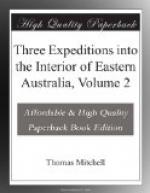Our guide was now joined by some older natives, and one of them had been examining the country ahead, being anxious about the safe passage of our carts. His reconnaissance had not been made in vain, for he led us to an easy, open pass through a range of which we had heard much from stockmen as likely to trouble us because, as they said, its rocky extremities overhung the creek. We crossed it with ease however, guided by the native. It consisted of granite and evidently belonged geologically to the ridge traversed by us on the second day after leaving Buree during our last journey. On the range, green pine trees (callitris) and a luxuriant crop of grass covering the adjacent country, multitudes of fat cattle were to be seen on all sides. I had heard that, after crossing the burnt up surface of the colony, I should see green pastures here, beyond its limits.
Cross Byrne’s creek.
We crossed Byrne’s creek, near a cattle station called Lagoura, and after keeping its banks for four miles further (having for that distance granitic hills on our right) we finally quitted it, and passed over a grassy plain of the same kind of soil and character as those extensive level tracts seen during our last journey but having, what seemed singular to our unaccustomed sight, a coating of green herbage upon it.
New plants.
In our progress I found no fewer than three new species of the pretty genus Trichinium;* a small species of Sida before undiscovered, with minute yellow flowers,** and also a fine-looking acacia with falcate leaves, singularly white or rather silvery, and with drooping graceful branches.***
(Footnote.
1. Tr. alopecuroideum, Lindley manuscripts; caule ramoso glabro, foliis lanceolatis glabris subtus scabriusculis, spicis cylindraceis elongatis, bracteis rotundatis, calycibus herbaceis sursum calvis acutis, rachi pilosa, cyatho staminum dentato.
2. Tr. parviflorum, Lindley manuscripts; foliis ovatis acutis petiolatis subtus et caule furfuraceo-tomentosis, spicis gracilibus elongatis, bracteis acuminatis scariosis, calycibus lanatis, rachi lanata, staminibus inaequalibus distinctis.
3. Tr. sessilifolium, Lindley manuscripts; foliis oblongis obtusis sessilibus et caule furfuraceo-tomentosis, spicis oblongis, bracteis rotundatis lanatis, calycibus longe tubulosis lanatis sursum pilosis, rachi tomentosa, staminibus inaequalibus distinctis.)
(**Footnote. S. corrugata, Lindley manuscripts; incana, prostrata, pusilla, foliis subrotundis angulatis cordatis palminerviis serratis, pedunculis 2-3 filiformibus petiolis longioribus, fructu disciformi corrugato, coccis monospermis commissuris muricatis.)
(***Footnote. This proved to be a very distinct, undescribed species. A. leucophylla, Lindley manuscripts; gracilis, ramulis filiformibus angulatis albido-sericeis, phyllodiis lineari-lanceolatis falcatis apice uncinatis obscure 2-nerviis appresse et densissime sericeis: margine superiore basi subglanduloso, racemis umbellatis axillaribus phyllodio multo brevioribus.)




